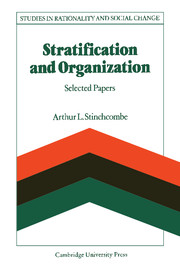Book contents
- Frontmatter
- Contents
- Acknowledgments
- 1 Rationality and social structure: an introduction
- PART I STRATIFICATION
- 2 Agricultural enterprise and rural class relations
- 3 Some empirical consequences of the Davis-Moore theory of stratification
- 4 Interdependence and inequality: a specification of the Davis-Moore theory (Co-authored with T. Robert Harris)
- 5 Marxist theories of power and empirical research
- 6 Social mobility in industrial labor markets
- 7 The sociology of ethnic loyalties
- 8 The deep structure of moral categories, eighteenthcentury French stratification and the Revolution
- PART II ORGANIZATIONS
- PART III SOCIOLOGY AS A PROFESSION
- Bibliography
- Name and place-name index
- Subject index
6 - Social mobility in industrial labor markets
from PART I - STRATIFICATION
Published online by Cambridge University Press: 06 July 2010
- Frontmatter
- Contents
- Acknowledgments
- 1 Rationality and social structure: an introduction
- PART I STRATIFICATION
- 2 Agricultural enterprise and rural class relations
- 3 Some empirical consequences of the Davis-Moore theory of stratification
- 4 Interdependence and inequality: a specification of the Davis-Moore theory (Co-authored with T. Robert Harris)
- 5 Marxist theories of power and empirical research
- 6 Social mobility in industrial labor markets
- 7 The sociology of ethnic loyalties
- 8 The deep structure of moral categories, eighteenthcentury French stratification and the Revolution
- PART II ORGANIZATIONS
- PART III SOCIOLOGY AS A PROFESSION
- Bibliography
- Name and place-name index
- Subject index
Summary
The purpose of this paper is to analyze the partition of the labor market into segments, and to show how this affects the process of social mobility. By labor market segments we mean bounded areas within the labor market such that people within those boundaries do not compete with people outside to more than a limited extent. For example, if physicians are licensed, other people who are not licensed compete with physicians only at a substantial disadvantage, as ‘quacks.’ If the vice-president for sales of a corporation is recruited only among middle managers in the corporation, then contenders for the job do not need to worry about what the going wage for vice-presidents is, for they will get somewhat more than a middle manager and less than a chief executive. When a labor market is divided up into segments, we can speak of the structure as a whole as ‘balkanized’. (Cf. Clark Kerr 1954. Recent work by Ross Stolzenberg (1975) and Aage Sørensen & N. Tuma (1978) bear very directly on the relation between Kerr's arguments and the modern mobility literature.) We will apply the ideas to some data on social mobility in Norway.
There are two dimensions to labor market segmentation which can be illustrated by contrasting farming with university teaching. Among farmers in the United States or Norway, most of the labor is recruited from among the families of farm owners of the previous generation.
- Type
- Chapter
- Information
- Stratification and OrganizationSelected Papers, pp. 86 - 121Publisher: Cambridge University PressPrint publication year: 1986



